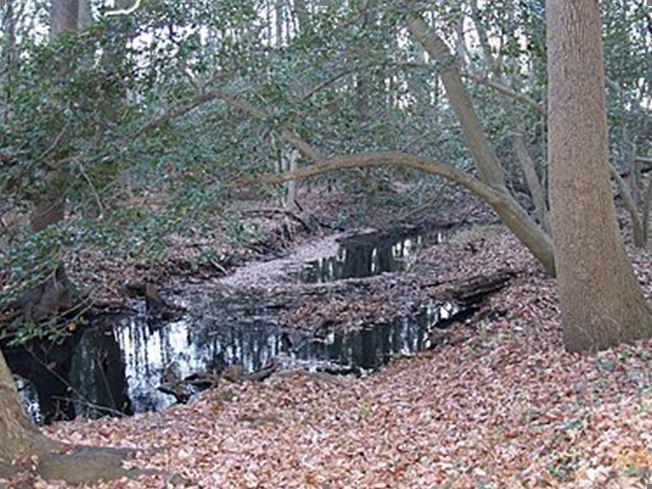Runoff from agricultural areas caused high bacteria levels in Delaware’s Iron Branch of Indian River Bay. As a result, the Delaware Department of Natural Resources and Environmental Control (DNREC) added the watershed to the 1996 Clean Water Act (CWA) section 303(d) list of impaired waters for bacteria. Watershed stakeholders provided technical assistance and installed agricultural best management practices (BMPs) in the watershed, causing bacteria levels to improve. As a result, DNREC removed Iron Branch from the state’s list of impaired waters for bacteria in 2020.
Iron Branch is a 23.15-square-mile watershed in the Indian River Bay watershed on the southeastern edge of Delaware in Sussex County. The Indian River Bay watershed is one of three interconnected watersheds that make up Delaware’s Inland Bays (Rehoboth, Indian River and Little Assawoman bays). Primary sources of nonpoint source pollution in the watershed include runoff from agricultural activities (e.g., fertilizer and manure application) and concentrated areas of animal production.

Monitoring data collected indicated that Iron Branch failed to meet the state’s enterococcus bacteria numeric criterion, which requires that the annual geometric mean be less than 100 colony-forming units (cfu) per 100 milliliters (mL) to support the freshwater primary contact designated use. As a result, DNREC added the Iron Branch watershed to Delaware’s 1996 CWA section 303(d) list of impaired waters for bacteria. Elevated nutrient levels also prompted the 1996 listing of Iron Branch as impaired due to nitrogen and phosphorus.
In 1998, DNREC developed a total maximum daily load (TMDL) to address nutrient loading throughout the Inland Bays watersheds, which includes Iron Branch. The TMDL stated that the nonpoint source nitrogen and phosphorus loads from the upper Indian River tributaries, which include Iron Branch, should be reduced by 85% and 65%, respectively. This was expected to reduce nitrogen loads from 2,833 pounds per day (lbs/day) to 425 lbs/day and phosphorous loads from 84 lbs/day to 29 lbs/day. Reducing nutrient sources should also reduce other nonpoint source pollutants, such as pathogens.
Delaware’s U.S. Department of Agriculture’s (USDA’s) Conservation Reserve Enhancement Program (CREP) was established in 1999 to protect and enhance environmentally sensitive land and waters in the coastal plain geographic areas of the Delaware, Chesapeake and Inland Bays watersheds by establishing voluntary land retirement agreements with agricultural producers. To assist in CREP program development and implementation, in 1999, Delaware’s Nonpoint Source Program committed CWA section 319 funds to create a full-time Delaware CREP Program Coordinator position. The CREP Program Coordinator helped install 2 acres of hardwood trees in the Iron Branch watershed.
The Sussex County Conservation District (SCD) offers technical assistance to the farming community by providing nutrient management planning and cost-share funding for agricultural BMPs. The SCD also partners with the USDA Natural Resources Conservation Service (NRCS) to develop conservation plans and Environmental Quality Incentive Program contracts. Watershed partners worked with landowners to enroll an average of 1,926 acres of cover crops and implement nutrient management plans on approximately 2,000 acres over 5 years (2015–2019).
Several BMPs were installed on operations within the watershed, including 21 manure storage structures, 15 poultry carcass composters, 34 heavy use area protection pads, among several other practices available through NRCS. The manure relocation program, in coordination with Delaware Department of Agriculture, transferred 4,667 tons of manure out of the watershed in 2015–2019. The SCD planners continue to work with farmers throughout the watershed, providing ongoing technical assistance to ensure improved water quality.
Bacteria levels have decreased in response to the more than 10 years of water quality protection and restoration efforts in the Iron Branch watershed (Figure 2). Data showed that the geomean levels were steadily declining: 362 cfu/100 mL in 2012, 280 cfu/100 mL in 2014, 252 cfu/100 mL in 2016, and 122.9 cfu/100 mL in 2018. The geometric mean of 41 samples collected by DNREC for 2020 at STORET Station 309041 (Iron Branch) indicated the lowest result of 95.8 cfu/100 mL. This is below Delaware’s fresh water bacteria water quality standard of 100 cfu/100 mL; therefore, DNREC removed the 13.1-mile segment of Iron Branch (DE-150-001-01) from the state’s list of impaired waters in 2020 per its Assessment and Listing Methodology. Nutrient loads have also declined due to the ongoing conservation work in the watershed, but levels do not yet consistently meet standards.
Key partners include SCD, NRCS and the Delaware Nonpoint Source Program. Between 2005 and 2020, NRCS supported implementation efforts within the watershed for $2.5 million. Over $321,000 in federal CWA section 319 funds supported the costs of the Iron Branch restoration effort. Because of the nature of the funding and enrollment procedures, the funding provided by watershed partners has been extremely important. Implementation efforts within the watershed are continuing, due in large part to the collaborations and working relationships formed by the partners and producers.
Related Topics: conservation, iron branch, nonpoint source, story, success, water quality, watershed